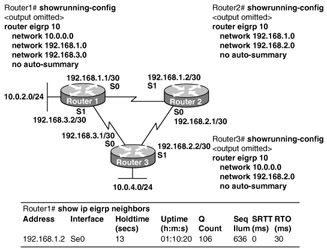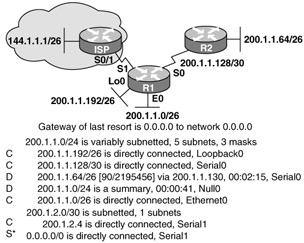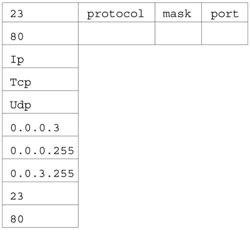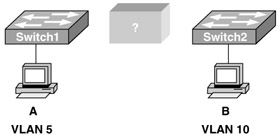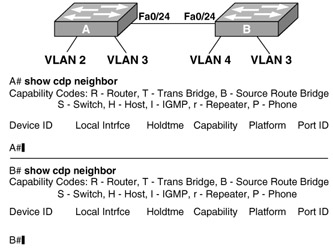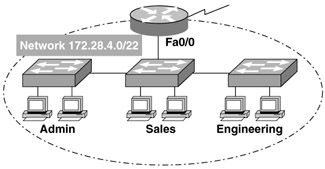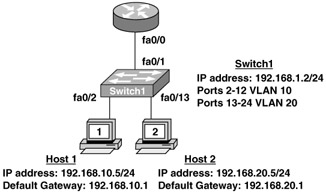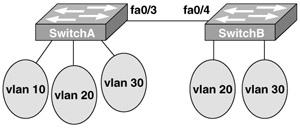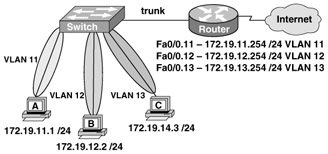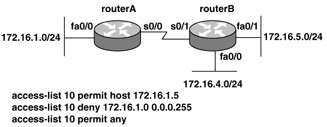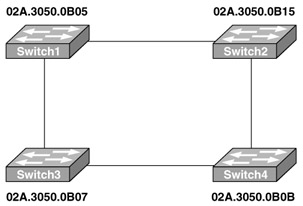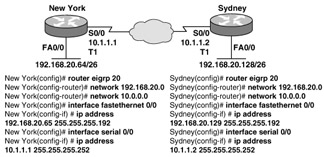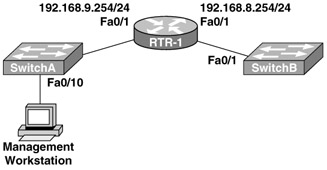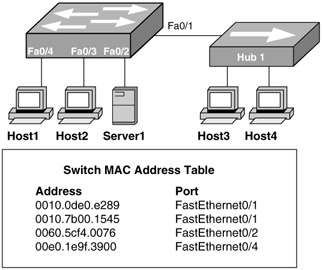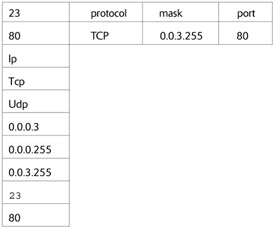CCNA-Practice Test 1
Directions: For each of the following questions, select the choice that best answers the question or completes the statement.
| 1. | Of the choices below, which one is needed for connectivity in a Frame Relay network if Inverse ARP isn't operational?
| | ||||||||||||||||||||||||||||||||||||||
| 2. | Look at Figure 1-1. As soon as SwitchB was added to the network, VLAN connectivity problems began cropping up. Why?
Figure 1-1 | | ||||||||||||||||||||||||||||||||||||||
| 3. | Look at Figure 1-2. Note both the IP addresses and how the network's routers are configured. Let's say the Sys Admin types in the show ip eigrp neighbors command from Router1 and gets the resulting output beneath the topology. Of the following, which is true?
| | ||||||||||||||||||||||||||||||||||||||
| 4. | Match each EIGRP item on the left with the correct interpretation on the right. (You won't use all the terms on the right.)
| | ||||||||||||||||||||||||||||||||||||||
| 5. | You're configuring a router to act as a hub within a Frame-relay hub-and-spoke topology. Why would you opt for using point-to-point subinterfaces instead of a multipoint interface?
| | ||||||||||||||||||||||||||||||||||||||
| 6. | Choose two of the following that best describe the process identifier used to run OSPF on a router.
| | ||||||||||||||||||||||||||||||||||||||
| 7. | Correctly complete the basic switch configuration by matching each switch IOS command in the left column to its relevant function in the right column.
| | ||||||||||||||||||||||||||||||||||||||
| 8. | How would the interface clock rate be established when a router is connected to a Frame Relay WAN link using a serial DTE interface?
| | ||||||||||||||||||||||||||||||||||||||
| 9. | Choose which of the following show ip interface command output options signifies a layer 1 problem.
| | ||||||||||||||||||||||||||||||||||||||
| 10. | Pick two of the following reasons why a network administrator would use access lists.
| | ||||||||||||||||||||||||||||||||||||||
| 11. | You have two routers directly connected via a serial link. One of them is made by Cisco; the other is a different brand. Choose the command you would use on a Cisco router to create a WAN connection between these two routers.
| | ||||||||||||||||||||||||||||||||||||||
| 12. | Look at Figure 1-3. In it, you can see a new, 60-host subnet that is now part of the network. Of the options below, which one best provides a sufficient number of usable addresses while also wasting the fewest addresses?
| | ||||||||||||||||||||||||||||||||||||||
| 13. | Choose two options that depict the information used by a router running a link-state protocol to create and sustain its topological database.
| | ||||||||||||||||||||||||||||||||||||||
| 14. | Look at Figure 1-4. Serial0/0 isn't replying to a ping from a host on the FastEthernet0/0 LAN. What would resolve this problem?
Figure 1-4 | | ||||||||||||||||||||||||||||||||||||||
| 15. | What can you accurately conclude by analyzing the router output depicted in Figure 1-5?
| | ||||||||||||||||||||||||||||||||||||||
| 16. | Which of the following best describes the purpose of Inverse ARP?
| | ||||||||||||||||||||||||||||||||||||||
| 17. | Look at the router table output in Figure 1-6. The corporate router receives an IP packet with a source IP address of 192.168.214.20 and a destination address of 192.168.22.3. Which of the following represents what the router will do with this packet?
Corp#show ip route … Gateway of last resort is not set C 192.168.13.0/24 is directly connected, Serial0/1 C 192.168.14.0/24 is directly connected, FastEthernet0/0 C 192.168.15.0/24 is directly connected, Serial0/0.102 C 192.168.20.0/24 is directly connected, Serial0/0.117 R 192.168.16.0/24 [120/1] via 192.168.15.2, 00:00:05, Serial0/0.102 R 192.168.17.0/24 [120/1] via 192.168.15.2, 00:00:05, Serial0/0.102 R 192.168.30.0/24 [120/2] via 192.168.20.2, 00:00:25, Serial0/0.117 R 192.168.19.0/24 [120/1] via 192.168.20.2, 00:00:25, Serial0/0.117 R 192.168.21.0/24 [120/3] via 192.168.20.2, 00:00:25, Serial0/0.117 R 192.168.214.0/24 [120/1] via 192.168.14.2, 00:00:22, FastEthernet0/0 Figure 1-6 | | ||||||||||||||||||||||||||||||||||||||
| 18. | You're testing an ISDN circuit that uses PPP between two IP hosts. Match the indicator in the left column with the OSI layer on the right that it confirms.
| | ||||||||||||||||||||||||||||||||||||||
| 19. | Look at Figure 1-7. One of the routers has 25 hosts with one connection to the Internet through the R1 router. Which routing configurations would be the best to implement on both the R1 and ISP routers?
| | ||||||||||||||||||||||||||||||||||||||
| 20. | Look at Figure 1-8. Which two of the following options depict what the output line of show ip route tells you?
Figure 1-8 | | ||||||||||||||||||||||||||||||||||||||
| 21. | Without a loopback interface, which of the following accurately describes what an OSPF router would use for the router ID if all OSPF routers in one area were configured with the same priority value?
| | ||||||||||||||||||||||||||||||||||||||
| 22. | Your VLAN with the subnet address of 172.16.4.0/22 contains hosts that must be prevented from accessing websites on the Internet. Match the options from the left column and write them on the right to fulfill this command: access-list 156 deny protocol 172. 16.4.0 mask any eq port. (Obviously, you won't use all the options.) | | ||||||||||||||||||||||||||||||||||||||
| 23. | Look at Figure 1-9. What would you use to enable communication between host A and host B?
| | ||||||||||||||||||||||||||||||||||||||
| 24. | Look at Figure 1-10. You have two 2950 switches that connect via ports Fa0/24 and a straight-through cable. What facts can you gain by combining the output of the show cdp neighbor command from both switches and the information given?
| | ||||||||||||||||||||||||||||||||||||||
| 25. | On which OSI layer does the protocol operate that imparts the information you get by using the show cdp neighbors command?
| | ||||||||||||||||||||||||||||||||||||||
| 26. | Figure 1-11 depicts a corporate LAN that uses IP network 172.28.4.0/22 for all departments. All hosts use 172.28.4.1 as a default gateway address. You've been called on to address the issue of excessive broadcasts slowing network performance. What would you do to resolve the problem?
| | ||||||||||||||||||||||||||||||||||||||
| 27. | Look at Figure 1-12. Pick the two commands you must configure on the 2950 switch and the router that will permit communication between host 1 and host 2.
| | ||||||||||||||||||||||||||||||||||||||
| 28. | Look at Figure 1-13. In it, you can see that the switches have been configured with static VLANs. But when testing, the Sys Admin finds that VLAN 20 on SwitchA isn't connecting with VLAN 30 on SwitchB. What steps should be taken solve this problem?
| | ||||||||||||||||||||||||||||||||||||||
| 29. | Of the choices below, which three host addresses are valid members of networks that can be routed across the Internet?
| | ||||||||||||||||||||||||||||||||||||||
| 30. | Choose the command that will configure a switch port to use the IEEE standard method of adding VLAN membership information into Ethernet frames.
| | ||||||||||||||||||||||||||||||||||||||
| 31. | Look at Figure 1-14 with these goals in mind:
Choose the two access list statements you need to achieve your objective.
| | ||||||||||||||||||||||||||||||||||||||
| 32. | Look at the newly installed network in Figure 1-15. Host B can access the Internet, but it can't ping Host C. Why?
| | ||||||||||||||||||||||||||||||||||||||
| 33. | If you needed to permit Internet access for the hosts in your network assigned addresses in the 192.168.8.0 through 198.168.15.255 range, which wildcard mask would you employ to achieve that objective?
| | ||||||||||||||||||||||||||||||||||||||
| 34. | Of the following situations, when would multiple copies of the same unicast frame be the most likely to be relayed in a switched LAN?
| | ||||||||||||||||||||||||||||||||||||||
| 35. | You've just inserted a new router into an established OSPF network, but the networks attached to the recently added router aren't showing up in the routing tables of the other OSPF routers. By looking at the information within the partial configuration given below, what's causing this issue?
Router(config)# router ospf 1 Router(config-router)# network 10.0.0.0 255.0.0.0 area 0
| | ||||||||||||||||||||||||||||||||||||||
| 36. | Choose two options that best describe the steps of the OSI encapsulation process.
| | ||||||||||||||||||||||||||||||||||||||
| 37. | Match and drag the security features in the column on the left to the exact security risks they help protect against in the right column. (You'll have some left over.)
| | ||||||||||||||||||||||||||||||||||||||
| 38. | You need to stop 172.16.1.5 from accessing the 172.16.4.0 network, but permit access to all other networks. Choose the command sequence that will properly apply this access list.
| | ||||||||||||||||||||||||||||||||||||||
| 39. | Your security policy dictates that only one host can be permitted to dynamically attach to each interface, and if this policy is violated, the interface should immediately shut down. Choose the two commands you need to configure on the 2950 Catalyst switch to implement your policy.
| | ||||||||||||||||||||||||||||||||||||||
| 40. | When analyzing Figure 1-17, what does the term dynamic mean as indicated in the output of the show frame-relay map command?
Figure 1-17 | | ||||||||||||||||||||||||||||||||||||||
| 41. | You're troubleshooting a connectivity issue when you notice that a port-status LED on a Cisco Catalyst series switch is alternating green and amber. What does this mean?
| | ||||||||||||||||||||||||||||||||||||||
| 42. | You need to reconfigure a Catalyst 2950, and you must make sure the old configuration is erased. Which two options will ensure you're successful?
| | ||||||||||||||||||||||||||||||||||||||
| 43. | Look at Figure 1-18. You've configured a new router and entered the copy startup-config running-config command on it. You power down the router and set it up at a remote location, but when it starts up, it enters the system configuration dialog shown in the figure. What's causing this to happen?
Figure 1-18 | | ||||||||||||||||||||||||||||||||||||||
| 44. | On point-to-point networks, OSPF hello packets are addressed to which address?
| | ||||||||||||||||||||||||||||||||||||||
| 45. | What is the purpose of spanning tree in a switched LAN?
| | ||||||||||||||||||||||||||||||||||||||
| 46. | Look at Figure 1-19. If all switches are set to the default priority setting, which switch will be the root bridge?
| | ||||||||||||||||||||||||||||||||||||||
| 47. | Looking at Figure 1-20, why hasn't the network converged?
| | ||||||||||||||||||||||||||||||||||||||
| 48. | Examine Figure 1-21. You've installed SwitchB, and you want to configure it to allow remote access from the management workstation connected to SwitchA. Choose the set of commands that will enable you to achieve this.
| | ||||||||||||||||||||||||||||||||||||||
| 49. | Choose the three feasible trunking modes for a switch port.
| | ||||||||||||||||||||||||||||||||||||||
| 50. | Which two commands would you use to configure running OSPF, plus adding network 192.168.16.0/24 to OSPF area 0?
| | ||||||||||||||||||||||||||||||||||||||
| 51. | You've configured an interface with the access list shown. Based on the access list, which information packets in the left column would be permitted, and which packets would be denied? Access-list 107 deny tcp 207.16.12.0 0.0.3.255 any eq http Access-list 107 permit ip any any
| | ||||||||||||||||||||||||||||||||||||||
| 52. | You've configured the Ethernet 0 interface of a router with address 10.64.0.1. 255.224.0.0 and the Ethernet 1 interface with address 10.96.0.1/11. Choose the two commands you would use to configure RIP version 1 on this router so it would advertise both networks to the neighboring routers.
| | ||||||||||||||||||||||||||||||||||||||
| 53. | Look at Figure 1-22, and give the reason the switch has two MAC addresses assigned to the FastEthernet 0/1 port in the switch address table.
| | ||||||||||||||||||||||||||||||||||||||
| 54. | A Class C network address has been subnetted with a /27 mask. Which of the following addresses is a broadcast address used for subnets?
| | ||||||||||||||||||||||||||||||||||||||
| 55. | Where are EIGRP successor routes stored?
| | ||||||||||||||||||||||||||||||||||||||
Answers
| 1. | B Explanation: B. Inverse ARP is used to resolve an IP address to local DLCI number. If a router does not support IARP or is used on the network, a frame-relay map must be configured for each PVC. | ||||||||||||||
| 2. | B Explanation: B. If the revision number of the new switch is higher, then the other switches will begin taking the new switches' update, which could cause connectivity problems. | ||||||||||||||
| 3. | B Explanation: B. From the output of the show ip eigrp neighbors command, the administrator can see that Router3 has not found Router1 as a neighbor. This is because Router3 does not have a network statement for the 192.168.3.1 network. | ||||||||||||||
| 4. |
Explanation:
EIGRP creates three tables to providing routing services, unlike RIP that creates only one. The three tables are neighbor table, which lists all adjacent neighbors; the topology table that lists every link in the network, called successor routers and feasible successor router (backup routes) and the routing table, where the success routes are copied from the topology table and placed. | ||||||||||||||
| 5. | A Explanation: A. In a case where split horizon is the problem, split horizon defines the rule "it is never useful to send routing information back in the direction from which it came." With this rule in place, routing updates that come from spoke routers would never be relayed from the hub router. By implementing point-to-point links and sub-interfaces on the spoke router, the routing protocol looks at each of the sub-interfaces as separate physical links, allowing the updates to go between each point-to-point link and update the spoke routers. | ||||||||||||||
| 6. | A, C Explanation: A, C The OSPF process id is locally significant and identifies each individual instance of OSPF that is running, should multiple instances be running on a single router. | ||||||||||||||
| 7. |
Explanation:
Switches do not need an IP address. It is very important that you remember this. IP addresses are used on a switch for management reasons only. The ip default-gateway command allows you to manage the switch from outside your local LAN or VLAN. If you do set an IP address, it would be set under the management VLAN, which by default is VLAN 1. A router or switch name is set by using the hostname command. You can set an IP address on an interface of a router or switch interface, logical or physical, by using the ip address command. The enable command allows you to access privledge mode. No shutdown enables and interface. All switch ports are enabled by default and the configure terminal command puts you into global configuration mode. | ||||||||||||||
| 8. | A Explanation: A. In a serial connection, only a device or the end of the cable is the DTE (router in most cases), and the other device or end of the cable is the DCE (CSU/DSU or ISP device). In this type of connection, the clock rate and control for the connection come from the DCE device. | ||||||||||||||
| 9. | C Explanation: C. In the interface output Serial0/1 is down, line protocol is down, the section Serial0/1 is down means that the interface is not receiving carrier detect; this is a physical layer (layer 1) problem. Line protocol is down means that the interface is not receiving keepalives from the remote router, which is considered a data link (layer 2) problem. | ||||||||||||||
| 10. | A, C Explanation: A, C. Access lists filter traffic as it is trying to pass through the router, and traffic generated at the router will not be filtered. Also, by placing an access list on the VTY lines, you can provide telnet security on your router. | ||||||||||||||
| 11. | B Explanation: B. Cisco uses the default serial encapsulation of HDLC, which is proprietary. If you have a Cisco router and a different brand of router on another side of the link, you have to use another encapsulation. One example is PPP. | ||||||||||||||
| 12. | C Explanation: C. Having 60 hosts on the network requires that at least 6 host bits be left from the network bits. 6 host bits will create 62 hosts on the network. Because network 192.168.1.64 is the next network, that will be the network id. With 6 host bits, that leaves 26 network bits or a /26 mask. | ||||||||||||||
| 13. | A, C Explanation: A, C. A router running a link-state protocol uses hello packets to find neighbors and form adjacencies. Once an adjacency has been formed, it will use link-state advertisement (LSA) packets to exchange topology information and updates when changes occur. | ||||||||||||||
| 14. | A Explanation: A. Administratively down means the interface must be enabled with the no shutdown command. | ||||||||||||||
| 15. | E Explanation: E. The D in the router output means the router is using EIGRP as a routing protocol. There are three directly connected networks attached to this router. | ||||||||||||||
| 16. | D Explanation: D. Inverse ARP is the automatic process of finding a DLCI from a known IP address. If this function is not available, then the mapping of the DLCI to the IP address must be done manually through the frame-relay map command. | ||||||||||||||
| 17. | B Explanation: B. Because there is no route entry for the 192.168.22.0 network, the router will discard the frame and use ICMP to tell the transmitting host (out fa0/0) that the network is unreachable. | ||||||||||||||
| 18. |
Explanation:
A successful dial session is the Physical layer, or layer 1, the "line is up" is a Data Link, or layer 2 function, and ping is a program that runs at the Network layer, or layer 3. | ||||||||||||||
| 19. | C Explanation: C. Because there is only one Internet connection, and the size and complexity of the network is small, default routes are the easiest and lowest overhead options for routing data. | ||||||||||||||
| 20. | D, E Explanation: D, E. The exhibit shows an entry from a routing table. The R to the left of the entry means the RIP routing protocol is being run. Moving to the right, 10.10.10.8 is the network that was learned. In the brackets [120/2], 120 is the default administrative distance (AD) for RIP, and 2 is the metric; for RIP, this is given in hops, meaning the network is 2 hops or routers away. | ||||||||||||||
| 21. | C Explanation: C. In the election process of OSPF routers, the priority value is checked first. By default, all routers have a value of 1. If a loopback interface is configured, the interface with the highest IP address is used. If there is no loopback interface, then the active interface with the highest IP address is used. | ||||||||||||||
| 22. |
Explanation: Web traffic uses HTTP, which is port 80. HTTP uses TCP at the Transport layer. Since the subnet mask is a /20, which is a block size of 4 in the third octet, the wildcard mask would be 0.0.3.255. | ||||||||||||||
| 23. | B Explanation: B. Because different VLANs are configured, different networks must be configured. In order to communicate from one network to another, a router is required. The router can be connected to each switch with a straight-through cable on different router interfaces. | ||||||||||||||
| 24. | C Explanation: C. When connecting two like devices together directly, a crossover cable must be used for them to communicate. | ||||||||||||||
| 25. | B Explanation: B. Cisco Discovery Protocol (CDP) is a Cisco proprietary protocol that works at the data link layer. | ||||||||||||||
| 26. | A Explanation: A. VLANs break up broadcast domains in layer-2 switched networks. Figure 1-11 shows all hosts in one broadcast domain, because switches do not break up broadcast domains by default. | ||||||||||||||
| 27. | B, E Explanation: B, E. By configuring logical interfaces on the router for each VLAN and then trunking the port from the switch to the router, and by using a frame-tagging encapsulation type of either 802.1q or ISL, inter-VLAN communication would occur at that router's interface. | ||||||||||||||
| 28. | C Explanation: C. When VLANs are configured, they provide a broadcast domain boundary or separate network. In order for a host to communicate from one network to another, a layer 3 or routing device is required. | ||||||||||||||
| 29. | C, E, F Explanation: C, E, F. To answer this question, the private address ranges must be known. There is a range in each class of addresses: 10.0.0.0-10.255.255.255, 172.16.0.0-172.31.255.255, and 192.168.0.0-192.168.255.255. Any of the options in these ranges will not be routed on the Internet. | ||||||||||||||
| 30. | F Explanation: F. There are two trunking encapsulation methods: ISL, which is Cisco propriety, and 802.1q, which is not proprietary. Use the command dot1q when using 802.1q. | ||||||||||||||
| 31. | A, B Explanation: A, B. The access-list statement access-list 101 permit tcp means that it is an extended list and will be used port numbers to filter the network. The next command is any and means "any source." The next command is the destination address and is specified by using the 0.0.0.0 wildcard. Finally, eq port tells the destination port number. | ||||||||||||||
| 32. | B Explanation: B. Host C's address is on the wrong network: It is on the 13 network, whereas its current IP is on the 14 network. | ||||||||||||||
| 33. | D Explanation: D. A wildcard is always one less than the block size. The third octet has a block size of 8, and the fourth octet has a block size of 256. This makes the mask 0.0.7.255. | ||||||||||||||
| 34. | D Explanation: D. If you do not have spanning-tree enabled on your switches, and you have redundant links, you will have broadcast storms and multiple frame copies. | ||||||||||||||
| 35. | C Explanation: C. OSPF uses an inverse mask to configure the network statement. The mask in this example should be 0.255.255.255. | ||||||||||||||
| 36. | A, D Explanation: A, D. This question is asking about Protocol Data Units (PDUs). The Transport layer creates segments and uses port number, the Network layer creates packets and uses logical addressing, the Data Link layer creates Frames and uses hardware addresses (MAC) and the Physical layer uses bits. | ||||||||||||||
| 37. |
Explanation:
The access-group command is used to place an access-list on a router interface. The console password is used to secure the console port, the enable secret is used to secure privileged mode, the VTY password is used for securing telnet access and the service password-encryption is used to encrypt your routers passwords in the configuration. | ||||||||||||||
| 38. | D Explanation: D. Because a standard access list is being used in this network, you should place the access list closest to the destination network. | ||||||||||||||
| 39. | A, D Explanation: A, D. By using the switchport port-security command, you can implement a security policy on your Catalyst switches. | ||||||||||||||
| 40. | E Explanation: E. You can statically map IP addresses to your local DLCI, or IARP will dynamically learn mappings. By default, IARP is enabled. | ||||||||||||||
| 41. | A Explanation: A. If a port on a switch is turning from green to amber and back again, there is some type of problem with the cabling or device connected to the switch. | ||||||||||||||
| 42. | C, E Explanation: C, E. If you erase the startup-config and reload the router, you will still have the VLAN database on the switch (vlan.dat, stored in flash). You must also delete the VLAN database to restore a switch back to factory defaults. | ||||||||||||||
| 43. | A Explanation: A. In this example, the administrator has incorrectly used the copy command. The correct syntax for this is copy "source file" "destination file". Because the configuration was made directly to the router, the changes were made to the running-configuration file stored in RAM. The permanent location for the configuration file is in NVRAM as the startup-configuration file. The command should have been copy running-configuration startup-configuration. | ||||||||||||||
| 44. | E Explanation: E. OSPF uses a multicast address of 224.0.0.5 to send hello packets to adjacent neighbors. | ||||||||||||||
| 45. | C Explanation: C. The spanning-tree protocol is used to prevent loops in the layer 2 switching topology by controlling or blocking the use of redundant links. In a layer 2 network, redundant links are not a bad thing, unless they are uncontrolled, because they provide a secondary path if the primary fails and thus eliminate single points of failure. | ||||||||||||||
| 46. | A Explanation: A. Switch1 has the lowest MAC address, which by default is used to find the root bridge. | ||||||||||||||
| 47. | A Explanation: A. The network shown in Figure 1-20 is a discontiguous network, and the no auto-summary command must be applied under the routing protocol. | ||||||||||||||
| 48. | C Explanation: C. By configuring an IP address, enabling interface VLAN 1, and then setting a default gateway with the ip default-gateway command, the switch will allow a remote host access for administrative purposes. | ||||||||||||||
| 49. | B, C, D Explanation: B, C, D. The three possible trunking modes include on, which means it is configured as "always" a trunk port and attempts to make the port on the far end of the segment a trunk port as well. This negotiation of trunk status is done using the dynamic trunking protocol (DTP). The next mode is desirable, which desires to be a trunk port send DTP frames, but can be an access port the other end will not be a trunk port. The third mode is auto, which becomes a trunk port if it receives DTP frames to become one; however it will not send DTP frames to change the other port. | ||||||||||||||
| 50. | B, E Explanation: B, E. When configuring OSPF to route on a network, the OSPF process must be started using the router OSPF <process id> command. Then, while in the router configuration mode, the network command can be used to add a network and enable interfaces to operate in OSPF. The network command in OSPF includes the network, a wildcard bit mask, and the area to which you want the network to belong. | ||||||||||||||
| 51. |
Explanation:
The wildcard 0.0.3.255 is a block size of 4, which means that the third octet will permit anything from 12 to 15. Also, the applicaiton is HTTP, so the access list will only permit port 80. | ||||||||||||||
| 52. | C, D Explanation: C, D. RIP, IGRP, and EIGRP are all configured the same way: with classful addresses, which means all default host bits are off. In this question, two networks are using the 10.0.0.0 classful network address. If you are studying for your CCNA exam, it would be wise to understand this type of configuration. | ||||||||||||||
| 53. | B Explanation: B. Multiple hosts can be connected to a switch port, by either a hub or another switch. All MAC addresses connected to that switch port will be placed into the CAM table. | ||||||||||||||
| 54. | E Explanation: E. With a /27 mask, the networks will increment by 32. The 201.57.78.128/27 network will have a broadcast address of 201.57.78.159. | ||||||||||||||
| 55. | E Explanation: E. EIGRP successor routes (the best routes) are stored in the topology table with all the other routes. Only the successor routes are then copied into the route table to be used for routing. |
